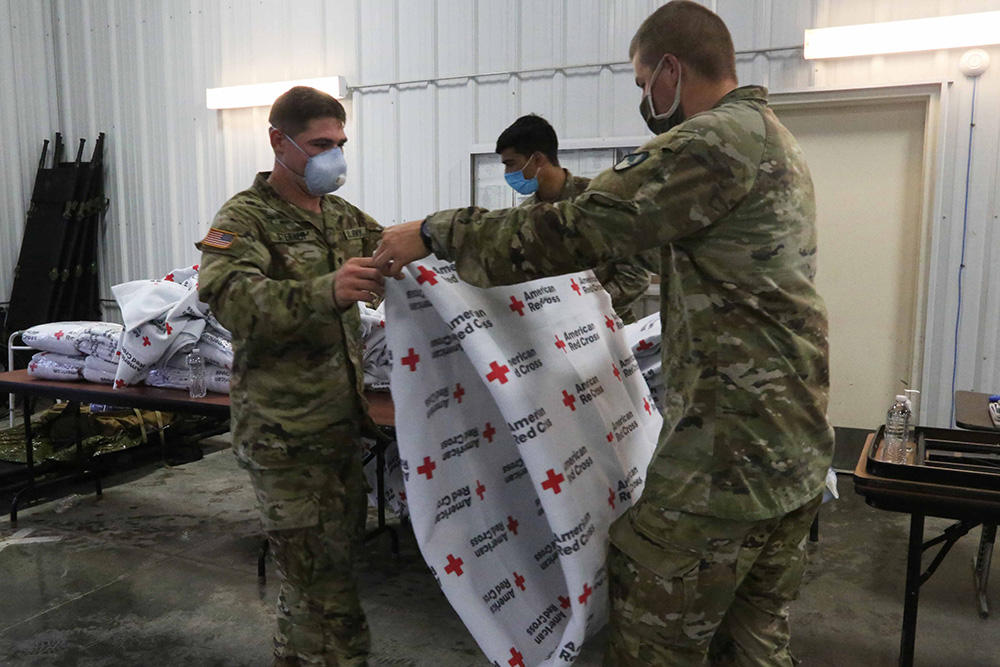As part of Operation Allies Refuge, the Defense Department is building capacity to house up to 50,000 Afghan evacuees on seven different military installations across the United States.
“The request for assistance from the State Department specifically requested that the Department of Defense provide culturally appropriate food, water, bedding, religious services, recreational activities and other services such as transportation from the port of entry to the location of accommodations, and some medical services as well,” Air Force Gen. Glen D. VanHerck, commander of U.S. Northern Command, said during a press conference today at the Pentagon.
Those services are now either being provided, or will be provided at Fort Bliss, Texas; Fort McCoy, Wisconsin; Joint Base McGuire-Dix-Lakehurst, New Jersey; Holloman Air Force Base in New Mexico; and Fort Lee, Marine Corps Base Quantico and Fort Pickett, all in Virginia.
Right now, capacity at Fort Lee, Fort Bliss, Fort McCoy, and Joint Base McGuire-Dix-Lakehurst stands at about 21,000 persons, though as the other three bases start bringing in evacuees, that number will grow. The department expects by September 15 to reach the full capacity of 50,000, and it’s possible also that new installations could be opened up to provide additional space if needed, VanHerck said.
Ports of entry for those evacuees now include both Dulles International Airport in Virginia, and Philadelphia International Airport in Pennsylvania. VanHerck said Northcom is supporting the Operation Allies Refuge at those transportation hubs by providing services and additional forces, including assisting with managing the flow of evacuees.

U.S. Soldiers assigned to 509th Clearance Company fold blankets for Afghans arriving at Fort McCoy, Wis., Aug. 26, 2021. © Army Spc. Eric Cerami
Onboard the installations currently housing evacuees, VanHerck said military efforts have been augmented by local communities and non-governmental organizations who are pitching in to ensure Afghans are well taken care of.
“They’re coming here, starting over with what they bring with them,” he said. “We’ve been incredibly well supported by the local communities, by the non-governmental organizations, etc., that have jumped in to help these families with things of need, such as diapers, formula, clothing — you name it.”
The general said at one location he could visit with one of the Afghans there to inquire about the conditions for him and his family.
“I asked them if they had what they needed, if they were doing okay, getting enough to eat, and getting enough … sleep,” he said. “The father thanked me, saying they had what they needed, and that it was the first time in a long time that he has slept without being afraid for his family’s safety.”
VanHerck said it’s been the tireless work of service members across the United States who have so far made the evacuation and resettlement effort a success.
“Thousands of Soldiers, Sailors, Airmen and Marines are working across the United States to complete this incredibly important mission to provide our Afghan colleagues a safe harbor while they finalize their immigration process,” VanHerck said. “I’m also grateful for the support of the community surrounding each of our bases and for the volunteers and others who are aiding in all of these efforts — together we are honoring our commitment to our Afghan partners and their families.”

Soldiers with 1st Battalion, 6th Infantry Regiment, 2nd Armored Brigade Combat Team, 1st Armored Division stack and inventory supplies at Dona Ana Village near Fort Bliss, Texas, Aug. 25, 2021. © Army Staff Sgt. Michael West





